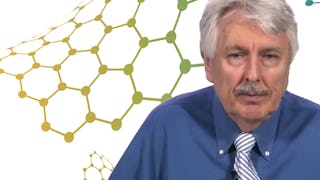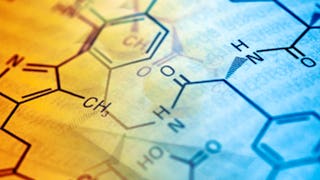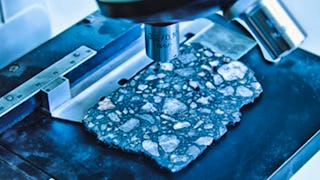This course will introduce age hardening and how to use a phase diagram to identify an alloy that is eligible for age hardening. The key factors that affect nucleation and crystal growth will be investigated. In addition, an introduction to polymer science will be given. The key differences between thermoplastic and thermosetting polymers will be introduced. Strengthening mechanisms will be introduced. We explore what happens to the properties of a polymer as you increase or decrease the extent of cross-linking. major polymer synthesis methods will be shown. We will review polymer selection for various applications. In addition, how structural properties vary with temperature will be presented. We explore the significance of the glass transition temperature of a polymer to its thermal and mechanical properties.

Gain next-level skills with Coursera Plus for $199 (regularly $399). Save now.

Hardening, Polymers, Properties
This course is part of Materials Science for Advanced Technological Applications Specialization

Instructor: Terry Alford
3,789 already enrolled
Included with
(91 reviews)
Recommended experience
What you'll learn
The use of the phase diagram to strengthen alloy steels and be able to predict microstucture during age hardening.
Skills you'll gain
Details to know

Add to your LinkedIn profile
See how employees at top companies are mastering in-demand skills

Build your subject-matter expertise
- Learn new concepts from industry experts
- Gain a foundational understanding of a subject or tool
- Develop job-relevant skills with hands-on projects
- Earn a shareable career certificate

There are 5 modules in this course
This course will introduce age hardening and how to use a phase diagram to identify an alloy that is eligible for age hardening. The key factors that affect nucleation and crystal growth will be investigated. In addition, an introduction to polymer science will be given. The key differences between thermoplastic and thermosetting polymers will be introduced. Strengthening mechanisms will be introduced. We explore what happens to the properties of a polymer as you increase or decrease the extent of cross-linking. major polymer synthesis methods will be shown. We will review polymer selection for various applications. In addition, how structural properties vary with temperature will be presented. We explore the significance of the glass transition temperature of a polymer to its thermal and mechanical properties.
What's included
1 video1 reading
In this module, we will discuss age hardening as a means of controlling the properties of various materials.
What's included
3 videos6 readings1 assignment2 discussion prompts
In this module, we explore the different kinds of polymers, polymer concepts and methods of polymer synthesis.
What's included
6 videos8 readings1 assignment3 discussion prompts
n this module, we will examine the different methods used to process polymers.
What's included
3 videos6 readings1 assignment2 discussion prompts
In this module, we will discuss the relationships between atomic and crystal structure and the thermal and mechanical properties of a material.
What's included
7 videos8 readings1 assignment1 peer review2 discussion prompts
Earn a career certificate
Add this credential to your LinkedIn profile, resume, or CV. Share it on social media and in your performance review.
Instructor

Offered by
Explore more from Mechanical Engineering
 Status: Preview
Status: PreviewGeorgia Institute of Technology
 Status: Preview
Status: PreviewGeorgia Institute of Technology
 Status: Free Trial
Status: Free TrialArizona State University
 Status: Free Trial
Status: Free TrialArizona State University
Why people choose Coursera for their career




Learner reviews
91 reviews
- 5 stars
69.23%
- 4 stars
17.58%
- 3 stars
4.39%
- 2 stars
5.49%
- 1 star
3.29%
Showing 3 of 91
Reviewed on Nov 18, 2023
I am thankful to COURSERA for achieving this mile stone
Reviewed on Feb 15, 2023
Being in the plastic industry as an Industrial Maintenance Tech in extrusion molding, this course was eye-opening.
Reviewed on Nov 24, 2024
Good thanks for the opportunity to learn from this course on Polymers and its characteristics

Open new doors with Coursera Plus
Unlimited access to 10,000+ world-class courses, hands-on projects, and job-ready certificate programs - all included in your subscription
Advance your career with an online degree
Earn a degree from world-class universities - 100% online
Join over 3,400 global companies that choose Coursera for Business
Upskill your employees to excel in the digital economy
Frequently asked questions
To access the course materials, assignments and to earn a Certificate, you will need to purchase the Certificate experience when you enroll in a course. You can try a Free Trial instead, or apply for Financial Aid. The course may offer 'Full Course, No Certificate' instead. This option lets you see all course materials, submit required assessments, and get a final grade. This also means that you will not be able to purchase a Certificate experience.
When you enroll in the course, you get access to all of the courses in the Specialization, and you earn a certificate when you complete the work. Your electronic Certificate will be added to your Accomplishments page - from there, you can print your Certificate or add it to your LinkedIn profile.
Yes. In select learning programs, you can apply for financial aid or a scholarship if you can’t afford the enrollment fee. If fin aid or scholarship is available for your learning program selection, you’ll find a link to apply on the description page.
More questions
Financial aid available,
¹ Some assignments in this course are AI-graded. For these assignments, your data will be used in accordance with Coursera's Privacy Notice.

